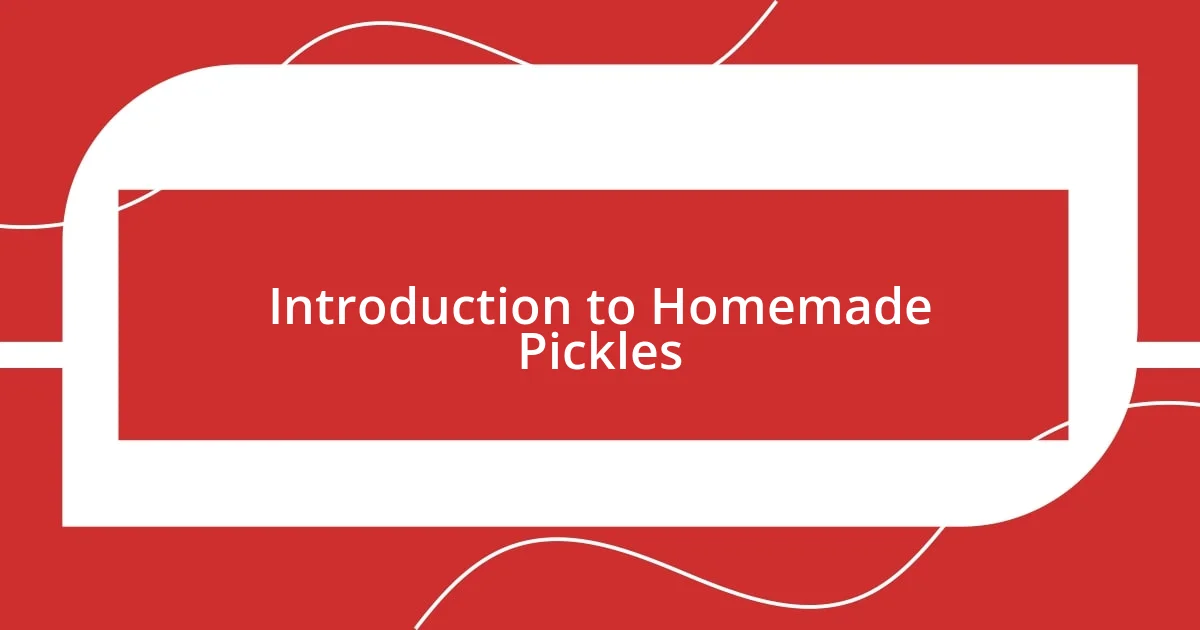Key takeaways:
- Making homemade pickles allows for control over ingredients, unique flavors, and the satisfaction of personal creativity.
- The pickling process is straightforward, requiring fresh cucumbers and a brine of vinegar, water, and spices, followed by patience for the flavors to develop.
- Pairing homemade pickles with burgers enhances flavors, balancing richness with tanginess, while experimenting with toppings and burger ingredients keeps meals exciting.

Introduction to Homemade Pickles
When I first dipped my toes into the world of homemade pickles, I was both excited and a bit intimidated. The crunch of fresh cucumbers, combined with the tangy crunch of vinegar and spices, promised something extraordinary. Have you ever wondered how something so simple could be elevated into a burst of flavor?
The process of making pickles is almost magical. It’s not just about preserving vegetables but infusing them with personality. I remember my first batch, filled with a mix of dill, garlic, and red pepper flakes. I couldn’t help but steal a taste before they were even ready; the anticipation was palpable. Each jar was a little gift to myself— a reminder of summer, even in the depths of winter.
What I find captivating is how homemade pickles can transform a meal. Whether they’re nestled beside a juicy burger or served as a zesty contrast to a rich cheese platter, they add a layer of flavor that store-bought versions just can’t match. It’s like bringing a piece of your kitchen’s creativity to every bite—don’t you want to experience that burst of homemade goodness?

Why I Chose Homemade Pickles
Choosing to make homemade pickles was an unexpected journey for me. I vividly recall the first time I sunk my hands into a fresh batch of cucumbers, feeling their coolness against my skin. The promise of transforming these simple vegetables into something luscious was thrilling. I wanted my pickles to reflect my taste and creativity, not just be another item off a grocery shelf. It felt like reclaiming a piece of my culinary independence—plus, homegrown flavors are just unbeatable!
Here are a few reasons why I opted for homemade pickles:
- Control Over Ingredients: I can decide exactly what goes into each jar, avoiding unnecessary preservatives and added sugars.
- Unique Flavors: Experimenting with herbs and spices allows me to create personalized recipes, like my favorite garlic dill with a kick.
- Freshness Guaranteed: There’s nothing like the crunch of freshly made pickles—they’re so much more vibrant than anything pre-packaged.
- Satisfying Process: The hands-on experience of pickling taps into my love for cooking, offering a fulfilling activity that brings an immense sense of accomplishment.
- Sharing with Loved Ones: I cherish gifting my homemade pickles to friends and family; their smiles and excited faces are the best rewards!

Step-by-Step Pickling Process
The pickling process is simpler than it might seem and can be a delightful way to spend an afternoon. I usually start by gathering my ingredients: fresh cucumbers, vinegar, water, salt, and spices. The delight of carefully selecting my cucumbers at the local farmer’s market always adds an extra special touch to the experience. Once I have everything, I wash the cucumbers thoroughly to ensure they’re clean and ready to absorb all the flavors.
Next comes the brine. I combine equal parts water and vinegar in a saucepan, adding salt and my chosen spices—sometimes I toss in some mustard seeds or a piece of chili for that extra zing. As it heats up, I can’t help but breathe in the sharp, tangy aroma that begins to fill the kitchen. It’s a smell that signifies something wonderful is about to happen. After the brine reaches a simmer, I pour it over the cucumbers packed tightly in jars.
After sealing the jars, I store them in a cool, dark place. Depending on the recipe and type of pickling, I typically wait a few days to a couple of weeks before I crack one open to taste. Patience is key here! I remember my first pickling adventure, staring at those jars for what felt like an eternity, but the first crunch of that perfectly seasoned pickle made it all worth it.
| Step | Description |
|---|---|
| Gather Ingredients | Choose fresh cucumbers, vinegar, water, salt, and spices. |
| Make the Brine | Combine water, vinegar, and salt over heat, adding spices. |
| Pack the Jars | Fill jars with cucumbers and pour the hot brine over them. |
| Seal and Store | Seal jars and store in a cool, dark place to pickle. |
| Wait | Leave jars for a few days to a couple of weeks before tasting. |

Tips for Perfect Pickles
To achieve perfect pickles, one crucial tip is to use the freshest cucumbers possible. I often stroll through my local farmer’s market, handpicking cucumbers that feel crisp and vibrant. It’s amazing how the freshness shines through in the final product; every bite becomes a burst of flavor. Have you ever noticed the difference in taste between a store-bought cucumber and one picked straight from the vine? It’s like night and day!
Another tip that has served me well is to let my brine cool slightly before pouring it over the cucumbers. I learned this the hard way during my early pickling days; pouring boiling brine directly caused my cucumbers to lose their crunch. This small change keeps them crisp and vibrant, enhancing that satisfying snap I crave with each bite. Isn’t it fascinating how such a minor adjustment can elevate your homemade pickles?
Finally, experimenting with spices is where the real magic happens. Whether it’s a dash of red pepper flakes or a handful of fresh dill, adding your personal touch can completely transform a recipe. The thrill of trying new combinations makes each batch an exciting adventure. Have you ever thought about what flavors resonate with you? Being adventurous with spices allows your pickles to reflect your palate, making every jar uniquely yours.

Ultimate Burger Recipe
When I think of the ultimate burger recipe, it all starts with the perfect patty. A mix of ground beef—preferably 80/20 for that blissful balance of juicy flavor—is essential for a burger that practically melts in your mouth. I remember the day I experimented with seasoning: a simple blend of salt, pepper, and a splash of Worcestershire sauce turned my basic burger into a flavor sensation. Have you ever noticed how just a hint of umami can elevate your dish to new heights? It’s moments like this that make cooking a rewarding experience.
Now, let’s talk toppings! I’ve learned that the essence of a great burger lies not just in the patty but also in what you choose to crown it with. Crisp lettuce, a thick slice of ripe tomato, and, of course, my homemade pickles add that necessary crunch and tang. The first time I piled everything onto a bun, I was struck by the colorful presentation and the aroma wafting from the grill. Isn’t it thrilling to create something visually appealing and delicious?
Finally, the bun needs just as much love. I always opt for a fresh, slightly toasted brioche bun; it’s sweet enough to complement the savory elements without overpowering them. You won’t believe how a little crispiness on the edges can enhance the overall texture of your burger. The joy I felt during my last backyard barbecue, when my friends devoured my burgers, was simply unbeatable. Have you ever had that satisfying moment when everyone loves what you’ve created? It reminds me why I love crafting the ultimate burger!

Pairing Homemade Pickles with Burgers
Adding homemade pickles to burgers is like discovering a missing puzzle piece; it elevates the entire experience. I remember a summer barbecue when I first stacked a thick slice of my dill pickles onto a juicy beef patty. The moment that tangy crunch combined with the savory meat, I realized I had found my go-to combination. Have you ever experienced that flavor explosion that makes you think, “Why didn’t I do this sooner?”
The acid from the pickles cuts through the richness of the burger beautifully. It’s like a refreshing contrast that balances everything out. I make it a point to use crispy, tangy pickles, particularly when grilling burgers topped with smoky barbecue sauce. This pairing not only enhances the taste but also ensures that each bite is exciting and dynamic. I can still recall the first time I introduced friends to this flavor marriage; their surprised smiles were priceless!
Not all pickles are created equal, though. I’ve tried sweet pickles and found they don’t quite mesh with my savory burger instinct. Instead, I stick with briny ones that add that satisfying tartness I crave. I once whipped up a batch of spicy pickles just for a burger night, and they became the highlight of the meal, proving that experimentation can lead to delightful surprises. Have you ever played around with varying pickle types on your burgers? The right pickles can truly transform them into a gourmet experience.

Conclusion and Recommendations
Creating homemade pickles and burgers has been a delightful journey, one that I wholeheartedly recommend to anyone looking to elevate their summer cookouts. If there’s one piece of advice I can offer, it’s to take your time with the pickling process. I recall rushing my first batch of pickles, only to find they lacked the depth of flavor I craved. You’ll be surprised how letting them soak and develop their character changes the entire experience!
When it comes to burgers, don’t shy away from experimenting. I often swap ingredients to keep things fresh—like using ground turkey instead of beef or exploring various spices. One unforgettable evening, I decided to incorporate some feta cheese and fresh herbs into the beef, and the result was astounding! Have you ever surprised yourself with a twist on a classic that turned out to be a winner?
Lastly, don’t forget the power of presentation. I find that taking a moment to artfully arrange my burgers can make the meal feel special. The last time I set up a beautifully plated burger spread, my guests couldn’t stop snapping photos! So, whether you’re hosting friends or just enjoying a quiet evening at home, let the colors and textures of your dish speak volumes. Your culinary creations deserve it, don’t you think?














